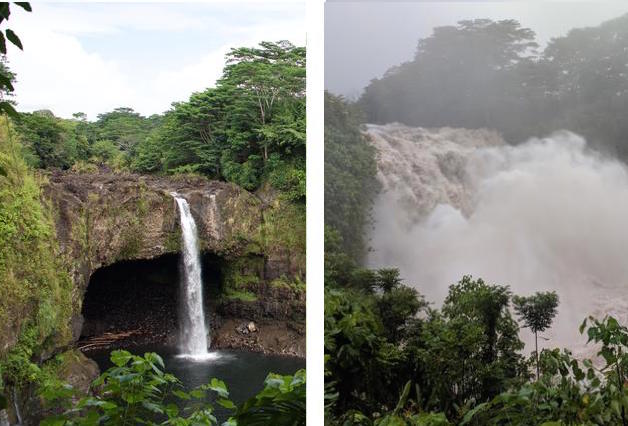Research reveals how Hurricane Lane brought fire and rain to Hawai‘i
 Two views from the Rainbow Falls overlook near Hilo, Hawaiʻi—left shows typical flow; right shows the early impact of Hurricane. Credit: Left: Ryan McClymont, Right: Gordon Tribble, USGS.
Two views from the Rainbow Falls overlook near Hilo, Hawaiʻi—left shows typical flow; right shows the early impact of Hurricane. Credit: Left: Ryan McClymont, Right: Gordon Tribble, USGS. Hurricane Lane was an impactful event for the Hawaiian Islands. In August 2018, over a four-day period, the island of Hawaiʻi received an average of 17 inches of rainfall, with a four-day single-station maximum of 57 inches, making Hurricane Lane the wettest tropical cyclone ever recorded in Hawaiʻi. A recently published study, led by University of Hawai‘i at Mānoa researchers, details the compounding hazards—fire and rain—produced by the storm.
“In this study we document what we believe to be the first instance of a hurricane causing both heavy rainfall and contributing to multiple instances of fire simultaneously,” said Alison Nugent, lead author of the study and assistant professor of Atmospheric Sciences in the UH Mānoa School of Ocean and Earth Science and Technology (SOEST).
A team of UH Mānoa and East-West Center scientists analyzed multiple aspects of the storm’s meteorology and climatology, the environmental conditions leading up to the storm, and documented the associated societal impacts.
They found that land-use characteristics and preceding moisture conditions exacerbated fire hazard, and both fire and rain severity were influenced by the hurricane environment and local topographic features. Conditions at the edge of the storm resulted in dry windy weather conducive to fire, while closer to the storm center, the incredibly moist atmosphere lifted by Hawai‘i’s mountains brought intense, long-lasting rainfall. The simultaneous occurrence of rain-driven flooding and landslides, strong winds, and multiple fires complicated emergency response.
The vulnerability of a population in any given location to the impacts of tropical cyclone hazards is determined by a multitude of interacting factors. Biophysical aspects include distance inland from the coast, terrain slope, coastal ecosystem integrity, and land surface cover. Socioeconomic factors include infrastructure quality, the availability of early warning systems, and capacity for evacuation and emergency response.
“The surprising thing about Hurricane Lane was that, despite never making landfall, the storm caused considerable damage and disruptions across the state from two rather contradictory things: fire and rain,” said Nugent. “Severe flooding on the windward island of Hawaiʻi Island built over several days, and multiple fires initiated on the leeward sides of Maui and Oʻahu within hours of each other. Hurricane Lane is one of only three documented cases of hurricanes influencing wildland fire risk in real-time.”
In Hawaiʻi, landfall by hurricanes is relatively rare due to persistent vertical wind shear over the islands, which weakens hurricanes by essentially tipping them over. However, when hurricanes do occur near Hawaiʻi, the geography of the islands can exacerbate the hazards. The nearly 750 miles of coastline makes much of the state susceptible to coastal flooding, and the mountainous topography can enhance high-intensity rainfall, as well as intensifying wind speeds. In addition, the steep mountainous terrain can enhance flash flooding and trigger landslide events.
The study highlights Hawai‘i’s vulnerability to natural hazards and reveals that these events can place significant constraints on emergency responders. This research also demonstrates UH Mānoa’s technical expertise across multiple disciplines—climatology, meteorology, water resources, fire science—to assess and predict the impacts of natural hazards and other climate-related events.
In the future the team plans to develop the analytical approaches and Hawai‘i-focused climate products needed to assess and prepare for future impacts, especially in the context of a changing climate where intensity and frequency of extreme events is likely to increase.
Ryan Longman with the East-West Center; Clay Trauernicht, Matthew Lucas, Henry Diaz and Thomas Giambelluca with the University of Hawaii at Mānoa are also co-authors on the study. This work was partially supported through the National Science Foundation EPSCoR project, ‘Ike Wai.
Read also on Hawaii News Now, West Hawaii Today, The Garden Island, Newswise, Phys.org and Eurekalert.


